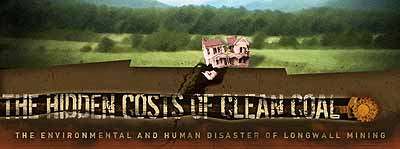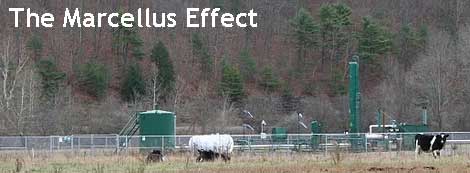Chemicals Used in Natural Gas Operations. Includes videos, photos, background information.
"TEDX (The Endocrine Disruption Exchange, Inc.) is the only organization that focuses primarily on the human health and environmental problems caused by low-dose and/or ambient exposure to chemicals that interfere with development and function, called endocrine disruptors."
See: Democracy Now! video interview with TEDX founder, Dr. Theo Colburn: The Health Effects of Water Contamination from Fracking.
Tennessee Gas Pipeline Company, a subsidiary of El Paso Corporation, plans to increase the capacity of its 300 Line to transport new diversified natural gas supplies, including newly accessed Appalachian and Marcellus shale gas to serve the growing demand for interstate natural gas transmission service in the northeastern United States.
The BP Oil Spill (2010) has demonstrated that safety concerns in the drilling of oil and gas were not adequately regulated offshore. Onshore accidents pose a risk that needs further study and monitoring.
St. Petersburg Times. Monday, July 26, 2010. "Oil companies' gulf spill history is a dirty secret."
The oil and gas industry's offshore safety and environmental record in the Gulf of Mexico has become a key point of debate over future drilling, but that record has been far worse than is commonly portrayed by many industry leaders and lawmakers.
See Also: Tennessee Gas Pipeline Fire
Bay St. Louis, MS - EPA Region IV
At approximately 1630 hrs. on 7/6/04 an AST containing 2370 gallons of waste oil was directly struck by a lightning bolt causing the tank to explode and igniting a neighboring tank containing 3700 gallons of petroleum distillants. The waste oil tank was later located approximately 175 yards away from it's pad. The waste oil was consumed in the fire.
Tennessee Gas Pipeline (Tennessee) is one of the five interstate pipelines that make up El Paso Corporation’s Pipeline Group. Tennessee is comprised of approximately 14,200 miles and 1.4mm certificated horsepower.
The pipeline stretches from the Mexican border to Canada. Tapping supply regions in the Gulf of Mexico, Texas, Appalachia, and Canada, the Tennessee system serves markets across the Midwest and mid-Atlantic regions, including major metropolitan centers such as Chicago, New York, and Boston.
In the 1970s, Congress passed a host of environmental laws that sought to adopt a preventive approach to reducing disease and protecting health and environment. Since then, average body burdens of some persistent toxic materials such as lead and cadmium have fallen, but those of other newer materials, like persistent flame retardants, have risen.
The major obstacle to a protective chemicals management system remains the culture of trade secrecy that allows firms to withhold information about potential health and safety dangers of their products. In my book, The Secret History of the War on Cancer, and in recent testimony to the President’s Cancer Panel on cancer prevention, I have advanced the concept of a Truth and Reconciliation Commission on Toxic Hazards.
The current regulatory system has failed to protect workers, their families and communities. Under the present adversarial system, companies can legally withhold information on the dangers of workplace hazards under the rubric of trade secrets, and they can also legally conceal information on health hazards as part of sealed settlement agreements...
Author's note: This essay is in response to: What is the key obstacle to implementing an effective, health-protective, chemicals management system?
See: Sandra Steingraber. Living Downstream: An Ecologist's Personal Investigation of Cancer and the Environment
See: Marcellus-Shale.us. "Our Look at the The Halliburton Loophole":
This exemption (from the Clean Water Act - authorized by the Energy Policy Act of 2005) allows non-disclosure of the toxic ingredients used near wells and aquifiers in drilling and waste injection. The rush to exploit the Marcellus Shale (referred to by BP's Tony Heyward as a "game-changer") allows gas drillers to legally keep secret the contents of the fracturing fluids used in fracking. Endocrinologist Dr. Adam Law of Ithaca, New York recently testified at the EPA Hearings in Binghamton that doctors cannot treat patients for exposure to chemicals if they don't know what they were exposed to. TEDX, The Endocrine Disruption Exchange, directed by Dr. Theo Colborn in Colorado continues to investigate the relationship between health and environmental distress.
See: Poisoned profits : the toxic assault on our children
See: Tox Town
See: The National Children's Study (2010)
The National Children’s Study will examine the effects of the environment, as broadly defined to include factors such as air, water, diet, sound, family dynamics, community and cultural influences, and genetics on the growth, development, and health of children across the United States, following them from before birth until age 21 years. The goal of the Study is to improve the health and well-being of children and contribute to understanding the role various factors have on health and disease. Findings from the Study will be made available as the research progresses, making potential benefits known to the public as soon as possible.
See:Fracking: Implications for Human and Environmental Health
If you are predisposed to distrust big business and the bureaucrats who regulate it, then “Gasland,” a soberly muckracking film about the health and environmental dangers of the current nationwide rush to drill for natural gas, will light a flame in you...
The accumulation of stories and sympathetic faces is persuasive; it’s buttressed by testimony from scientists like Theo Colborn and Al Armendariz, named regional director of the Environmental Protection Agency in Dallas since the film was completed. Most viewers who seek out “Gasland” are likely to share Mr. Fox’s outrage (which he expresses in melancholy tones) and to accept the picture, familiar and so often true, of heedless profiteering, co-opted and ineffective regulation, Orwellian spin control and innocent, ruined lives. Comparisons to the oil spill in the Gulf of Mexico will be unavoidable...
Mr. Fox shows a general preference for vivid images — bright red Halliburton trucks, beeping but unidentified scientific instruments — over the more mundane crossing the t’s and dotting the i’s of investigative journalism...
Mr. Fox closes with an ominous warning about the threat fracking poses to New York City’s watershed. New Yorkers who are frightened at the prospect will want to know that the state recently tightened regulations governing drilling in that area, at least temporarily.
This is an excellent background on the Marcellus Shale Gas Rush. Website is sponsored by Shell which may signify a pro-industry editorialization. Nevertheless, the photographs and production are impressive. Shell's message here:
"Let's Build a Better Energy Future. Let's Go. See how we're helping to secure energy for the next generation."
See: Ed Pilkington. "Shell pays out $15.5m over Saro-Wiwa killing." The Guardian. June 9, 2009.
See: Jad Mouawad. "Shell to Pay $15.5 Million to Settle Nigerian Case." NYT. June 8, 2009.
Forcing Gas Out of Rock With Water
The populous mid-Atlantic market pays a relatively higher price than the South for energy, at the same time that exploration and finding costs are dramatically lower in the Marcellus than in the Barnett and the other shales around the United States.
“It’s very repeatable,” says Range spokesman Matt Pitzarella. “Every well in Washington County is either good or great.”
See: Candice O'Grady. "Newsweek Greenwashes the Oil Lobby for Real." Feb. 2010.
The Center for Public Integrity’s year-long investigation into the social and environmental impacts of longwall mining centered on hundreds of pages of documents obtained from government sources, such as the Pennsylvania Department of Environmental Protection and the U.S. Fish and Wildlife Service; legal agreements between coal companies and property owners; environmental studies; landowner letters; and federal and state records requests.
The library features key documents exemplifying key people or issues in each of the project’s magazine articles.
See: Resources Page:
This list of resources includes the websites of coal companies and citizens groups, as well as studies about and lawsuits over the impacts of longwall mining.
Blog by Sue Smith-Heavenrich reporting from Owego, New York.

Sue Heavenrich.
I am a freelance journalist, writing about Marcellus gas issues, the environment and science. I live in upstate NY, surrounded by forest and fields. There is gas beneath my feet. member: Society of Environmental Journalists; Society of Children's Book Writers & Illustrators.
A disturbing amount of the climate justice movement’s “action” is taken alone, within our own homes.
We sit at our computers and post, Tweet, comment and write op-eds. We call our Senators and legislators. We change our light bulbs and insulate our homes (literally and figuratively.)
The picture that naturally develops in our minds is of little me, sitting here fighting the world’s biggest corporations and their political stooges. That’s a pretty discouraging picture.
Despite all the attempts of social media to build “community,” everyone is still sitting alone at computers. We did not evolve to develop powerful relationships with an avatar, sending us an instant message.
That’s why a million screen names out there somewhere don’t help us deeply internalize the truth that we are part of something large and powerful. We evolved to connect with human beings that we can see, hear, smell and feel, and it is that kind of connection that empowers us on a deep level...
...The more I advocate for stronger and bolder action from climate activists, the more I see the need for real human connections. No amount of social media can match the empowerment of being in the streets with thousands of other people who share our passion. That’s why mass mobilizations that engage in bold action are so important for our movement.
Read joint letter explaining the urgent need for solidarity on December 13th.
See: "Student Disrupts Government Auction of 150,000 Acres Of Wilderness For Oil & Gas Drilling."
 For full interview click here.
For full interview click here.
See: Judge says drilling lease lawsuit too late
See: Tim DeChristopher's blog and update on his legal battle.
See: As climate crime continues, who are we sending to jail? Tim DeChristopher?
This article appeared in the June 21, 2010 edition of The Nation.
When a well is fracked—each well is generally fracked up to ten times—between 15 and 40 percent of the mix flows back to the surface. Companies operating in the Marcellus, which is naturally radioactive, must find a way to dispose of thousands of gallons of water, toxic chemicals, brine and radium.
There are several ways things can go wrong, Horwitt says. Fluids can be spilled during transport, they can travel underground through natural or man-made fractures, or they can contaminate nearby areas if they're not stored properly...
Citizen action groups have popped up all over the Marcellus region, including the Shaleshock Action Alliance and the Pennsylvania-based Damascus Citizens for Sustainability, and around the country.
On May 26 As You Sow, a shareholder advocacy organization representing the Park Foundation of Ithaca, won support from a surprising 26 percent of shares at ExxonMobil's annual meeting for a proposal that would have required the company to disclose its efforts to reduce risks from natural gas drilling. "The Gulf oil spill is a powerful example of how oil and gas drilling can devastate the environment," Park Foundation executive director Jon Jensen wrote in a statement. "This is a good first step in responsibly seeking energy in a way that protects the environment, human health, and the welfare of the company."
See: As You Sow | Mixplex
See: Dusty Horwitt. (2009). "Drilling Around the Law Report." Environmental Working Group. 24 pages.
See: Exxon Confronts Nuns, Calpers Over Global Warming Plans, Boskin
Cap-and-trade is deader than dead. Everyone in Washington officialdom knows that. Virtually no one in Washington officialdom understands how it would work or how much economists think it would cost, but they're certain it's bad, bad, bad and had to die.
Polluting industries and wealthy right-wing oligarchs, aided by a well-funded grassroots army, sympathetic conservative politicos, and a major cable TV news network, cast cap-and-trade as a plague of socialist cooties that would destroy the economy. The left's Purist Brigade wove florid tales of corruption and plutocracy. The reality -- a long, opaque, technocratic bill burdened with several high-profile side deals -- inspired no one. All the passion, all the anger, was found on the side of opponents.
4) The BP Gulf oil spill kills energy reform
5) The U.N. climate process saves itself
About Grist
You know how some people make lemonade out of lemons? At Grist, we're making lemonade out of looming climate apocalypse.
It's more fun than it sounds, trust us!
Grist has been dishing out environmental news and commentary with a wry twist since 1999 -- which, to be frank, was way before most people cared about such things. Now that green is in every headline and on every store shelf (bamboo hair gel, anyone?), Grist is the one site you can count on to help you make sense of it all.
Each day, we use our Clarity-o-Meter to draw out the real meaning behind green stories, and to connect big issues like climate change to daily life. We count on our users to bring their stories to the table, too -- through blogs, photos, and whatever else they care to share. Except Jell-O molds. Those things scare us.
Grist Staff Bio
David Roberts, Staff Writer
droberts@grist.org
206.876.2020 ext. 220
David was born and raised in the South. A revelatory summer working in Yellowstone National Park convinced him that it was not the world but just the part where he lived that sucked, so he moved out West. After several wayward years spent snowboarding and getting an MA in philosophy (go griz), he woke up with nothing but a dissertation between him and an arid, cloistered life spent debating minutiae with the world's other 12 Dewey scholars. So he bailed. A period was spent trudging through the swamp of Seattle tech work, wading past Amazon.com, IMDb.com, and Microsoft, before the fine folks at Grist fell for his devastating good looks in December 2003.
















